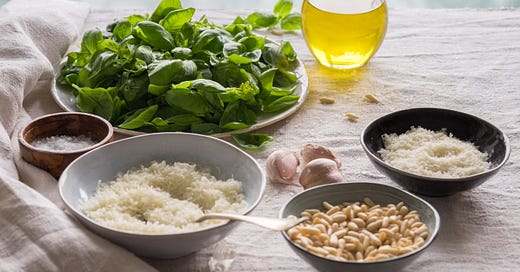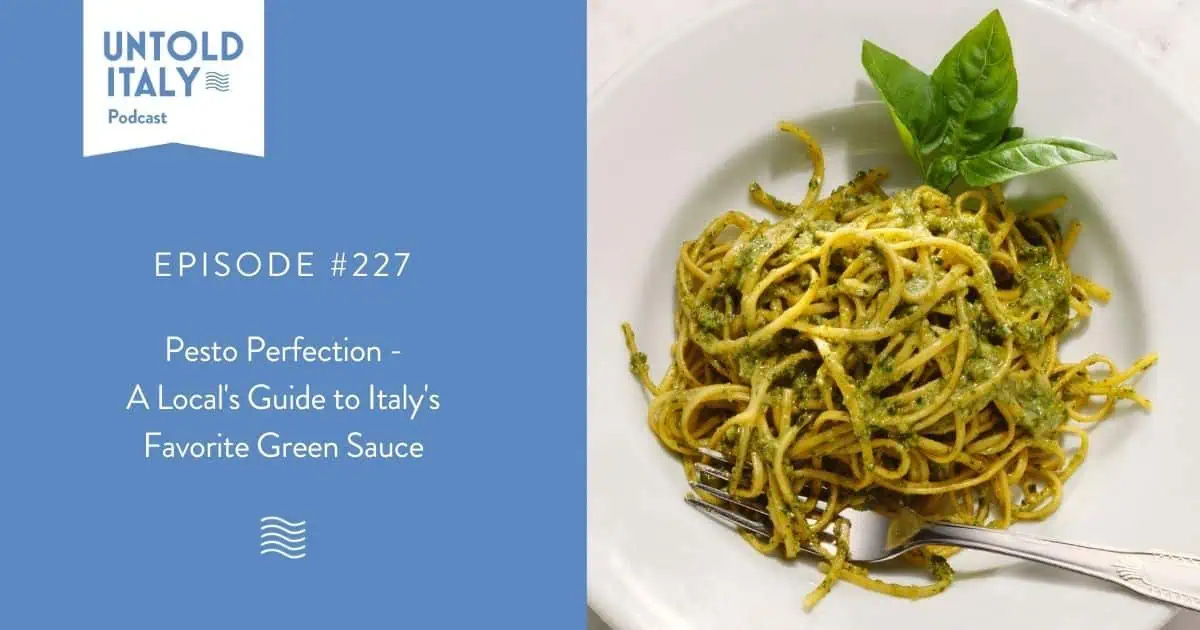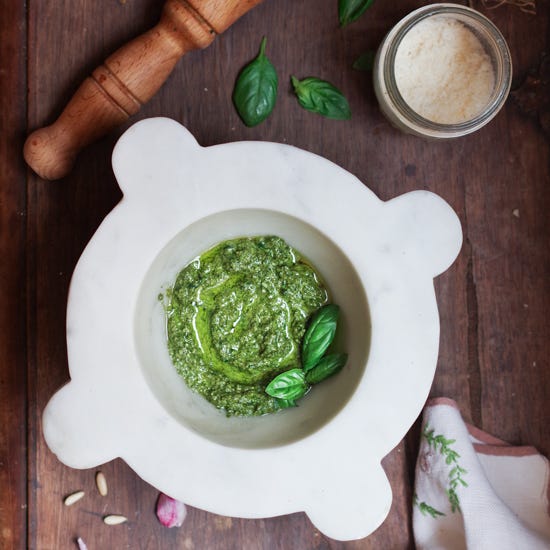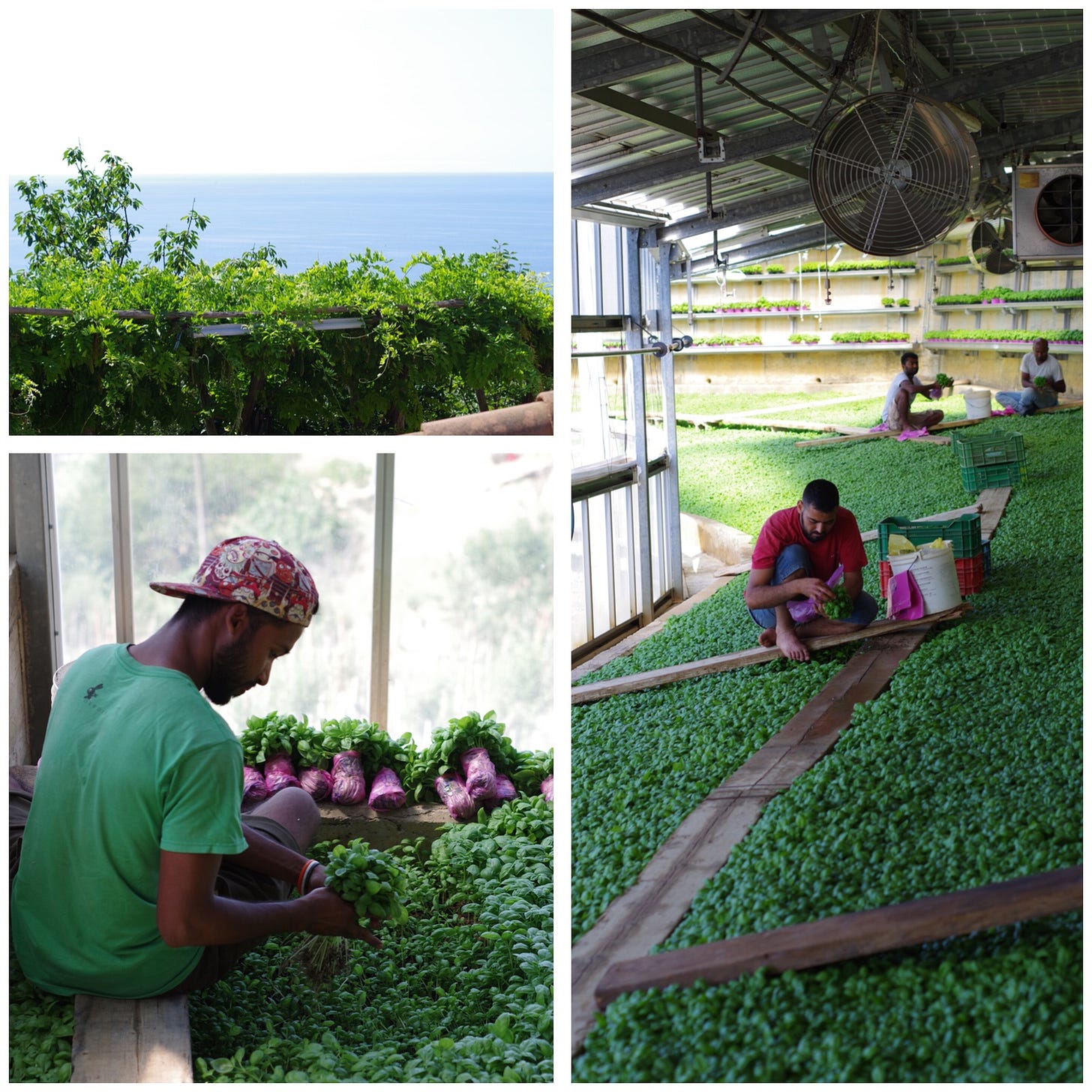Ligurian basil pesto, is it that very old traditional recipe?
Spoiler: no. A brief history of the most eaten green sauce in the world.
Often, during cooking classes, cleaning basil leaves sat around the table my guests ask me how old pesto recipe is.
In their imagination (and perhaps in that of many Ligurians too), pasta al pesto has always existed on Ligurian tables, perhaps they imagine rustic tables with red and white checked tablecloths where giant plates of steaming trenette al pesto are ready to feed large families.
Each time I have fun debunking this myth (as well as many others that now hover over Italian cuisine).
False, Genoese basil pesto is not a very old recipe. In the panorama of the many traditional Ligurian and Genoese recipes, we can say that pesto (genovese basil pesto) is a youngster.
If you want to listed to the history of pesto (and discover many other interesting things about this iconic sauce) I was recently interviewed on this subject by UntoldItaly Podcast. You can listen to the podcast clicking the bottom below!
Otherwise, keep on reading!
A brief history of basil pesto sauce.
Before we start a short clarification: “pesto” is the past participle of the verb pestare which means to beat/ to pound / to crush. In the culinary field this implies something beaten/pounded/crushed with a pestel in a mortar. Thefore, there are many “pestos” in the Italian Regional cuisine made with different ingredients (dried tomatoes, cappers, parsley in the South, for example). The story I’m going to tell you is that of the Genoese basil pesto, become so famous in the world to be named just “pesto”.
Let’s start.
I was saying that Genovese basil pesto (pesto) is not a very old traditional recipe.
Truth is, infact, that the recipe of the most famous Ligurian green sauce - made with Genovese basil leaves, garlic, pine-nuts, parmesan cheese and EVO oil – is the result of endless, casual, scattered, personal experiments inside a mortar.
It’s a recipe that actually developed over the centuries.
Since middle-ages a continuous mixing and pounding in the mortar of different ingredients - taking place in humble as well as in noble kitchens - eventually lead to the magical pattern and there definitely crystalized.
The base sauce, the ancestor of pesto, was a garlic sauce made crushing garlic in the mortar and mixing it with olive oil. A very common seasoning for meat, fish and vegetables on Middle Ages tables. Garlic indeed, with its antiseptic properties, was normally used to sanitize food long time ago.
This is the main reason why pesto without garlic – very popular in the last decade – to me is a nonsense.
Then little by little, people started adding fresh herbs. Liguria is well known for using fresh herbs as a main ingredient in lots of their recipes. So, cooks started adding in the mortar some fresh herbs picked in the backyard or on the window sill, but not necessarily basil. A couple of the oldest written Ligurian recipes we have about pesto (backdating around 1860) provides, indifferently, for parsley, marjoram, sage, basil, even them all together. The use of just basil is something that become popular only in the last century.
As to nuts, then, probably the first nuts used in this - let’s call it - “herby pesto sauce” were walnuts. Probably the Genoese learned to use walnut in sauces for seasoning from the Muslims, with whom they had intense trades during Middle Ages. Still nowadays in Middle East cuisine we can find different walnut sauce recipes for seasoning meats.
Then walnuts were replaced by pine-nuts. It’s not easy to say when and why. Actually scrolling the few ancient basil pesto recipes we have, pine-nuts are never mentioned among the ingredients but for one recipe (in “La Cucina di Strettissimo Magro” from Padre Gaspare delle Piane” ), especially written for “sacrifice days” when animal products consumption was forbidden. And here probably pine-nuts were used in lieu of cheese to give creaminess to the sauce.
There are also some area in the western backcountry of Liguria, where basil pesto still nowadays is made with walnuts instead of pine nuts. So, don’t worry, it’s not an heresy making basil pesto with walnuts: always better good walnuts rather than cheap, tasteless, old pine-nuts! (but no cashew please).
Coming to cheese, the story is even more curious.
Today we primarily use Parmigiano Reggiano, preferably matured, over 24 months.
In the past, in lieu of – or jointly with Parmigiano Reggiano - Genovese cooks largely used also matured Pecorino cheese from Sardinia (“Fiore Sardo”). This because Sardinia was historically a “colony” of the Genova Marina Republic and most of the pecorino cheese produced in Sardinia used to be shipped into Genova and then from here sold elsewhere in the north of Italy. This cheese, therefore, was commonly available in Genoa markets at reasonable low prices and used for daily cooking.
Pecorino Sardo though has a spicy, salty, smoky flavor and tend to be overwhelming. This is why when we make pesto nowadays, or we skip it at all or we use it in a very small percentage joinlty with Parmigiano Reggiano. Our palates are less “rude” than those of our ancestors!
For the very same reason (availability) some old recipes call for the Dutch cheese Edam (yes, the one with the red wax skin) in pesto! It may seem very strange but again this is because of the historical intense commercial relationships between Genoa and The Netherlands: in Genoa there was a big community of Dutch, importing, consuming and selling their cheese on our markets.
I have to mention also that in the Easter villages outside Genova, in Golfo del Tigullio, it’s a tradition to add to basil pesto a tablespoon of prescinseua, our local fresh sour cheese/curd (something in between ricotta and yogurt), to give extra creaminess and some acidity to the sauce.
Finally, extra virgin olive oil has always been – jointly with garlic - a pillar of the pesto recipe. Some old Ligurian cooks, though, does not disdain a nut of butter in the sauce, to make pasta al pesto even more delicious (just to let you know that this is the local hottest controversial topic when discussing with friends about the best pesto recipe).
In conclusion, the basil pesto recipe “codified” in the last decades probably was invented by chance.
Maybe one morning a home cook, after having crushed that fresh garlic clove in the mortar, looking around in the kitchen decided to put a handful of those shining basil leaves on the window sill, that grated Parmigiano left over from the evening before and those few pine-nuts laying in the jar. A pinch of rock salt and then she smashed, pounded, crushed rhythmically swinging her hips in the summer breeze. She stared proud at her thin paste in the mortar, she poured a thing string of gold extra- virgin olive oil, stirred gently and BLAM!, and the magic had happened.
Some more things about pesto you may like to know.
My pesto recipes
A long time ago I wrote on the blog a complete guide for making pesto, with a description in depth of the essential (current) ingredients, my recipes of course (with mortar and with blender), and many tips and tricks to make it at home like a local. You can read it here: https://www.asmallkitcheningenoa.com/pesto-sauce-recipe/
If you plan to travel in Liguria searching for pesto
This year I have added a bunch of new private experiences to my offer. One of these is the “Basil Farm and pesto making experience”.
It’s a one- day visit to the iconic Ligurian basil sea-view greenhouses. We will meet a warm and welcoming family who have dedicated its life to cultivating basil who will introduce you to the secrets of cultivating these aromatic leaves, from the perfect balance of soil and sunlight to the rhythm of the sea breeze. Then you will experience with me the joy of pounding fresh basil leaves and making pesto the traditional way, using a marble mortar and wood pestle.
Finally we will enjoy a traditional peasant menu prepared with organic ingredients straight from the vegetable garden, whose highlight, of course, will be fresh pasta seasoned with your freshly crafted pesto.
This is a private experience for groups (min. 6 people). If you are interested just send me an e-mail!
If you come to Genoa, I also organize basil pesto classes as an optional additional experience of my Genoa Food tours.
Where to eat pesto in Genoa
Beating and pounding is not your cup of tea? Maybe you would like to know where to eat a good plate of pasta al pesto in Genova.
Here some of my favorite traditional restaurants in Genova (and backcountry) that will meet or even exceed your expectations:
Il Genovese – via Galata, 35r – www.ilgenovese.com
Sà Pesta – via dei Giustiniani, 16r – www.anticasapesta.com
Trattoria della Raibetta – vico Caprettari, 16r - www.trattoriadellaraibetta.it
Il Tondin - Piazza dell’Amico 2 – www.iltondin.it
Trattoria delle Cicale – Via Ruspoli 55 r – www.lecicalegenova.it/trattoria
Baccicin du Caru – Via Fado 115 - Mele - https://www.facebook.com/BaccicinduCaru/?locale=it_IT
(my favorite, ever, but you need a car to get there)
Where to buy pesto in Genoa
Otherwise, if you look for some freshly made pesto to cook at home , here the places in Genova where I use to buy it in case of emergency:
Da Mario, pasta fresca – Via della Maddelana 22 r
Pesto bene – Via SanPietro della Porta 1 - www.pestobene.com
Il Troffiaio - Piazza Colombo 10 - www.iltrofiaio.it
At the supermarket, to me, the best fresh pesto is the one from Pastificio Novella (with garlic, needless to say).
I hope you liked today newsletter. If you have any question or experience about Genovese basil pesto you would like to share with me and the other subscribers, just …








Hello Enrica!
So happy I found your site today. I was searching for a recipe I had saved from my aunt. When I didn’t find it, I thought I’d try google to see what I would find. Our family has several recipes that I have not found elsewhere. Our ancestors come from an area north of Genoa called Santo Stefano d’aveto. Back to initial point - our family recipe calls for adding cream cheese to the recipe and mixing it with the pesto sauce (either pine or walnuts) Then before adding to the pasta, adding in some of the water from the pasta.
I have not read all your pesto recipes but was so excited to find your site and read your story on pesto I had to comment. It is interesting to see how our family recipes may have evolved since they migrated to America in the 1850s. Ps: I was looking for rice torte recipe which appears to be a version of savory rice pie.
Ciao!
Cheryl Bacigalupi
Cbacci@gmail.com
Ciao, va bene anche in italiano? Io sono genovesissima, e ti ringrazio molto per aver raccontato la vera storia del pesto, assolto il burro e le noci al posto dei pinoli, e insomma tutto quello che hai scritto. Tutta la cucina "tradizionale" italiana è frutto del caso e, soprattutto, di quello che c'era a disposizione al momento, visto che i supermercati non sono esattamente luoghi storici. Grazie!